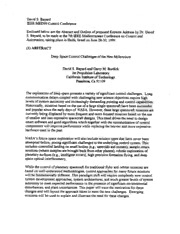
NASA Technical Reports Server (NTRS) 20000068537: Deep Space Control Challenges of the New Millennium PDF
Preview NASA Technical Reports Server (NTRS) 20000068537: Deep Space Control Challenges of the New Millennium
David S. Bayard IEEE MED99 Control Conference Enclosed below are the Abstract and Outline of proposed Keynote Address by Dr. David S. Bayard, to be made atthe 7th IEEE Mediterranean Conference on Control and Automation, taking place in Haifa, Israel on June 28-30, 1999. (1) ABSTRACT Deep Space Control Challenges of the New Millennium David S. Bayard and Garry M. Burdick Jet Propulsion Laboratory California Institute of Technology Pasadena, Ca 91109 The exploration of deep space presents a variety of significant control challenges. Long communication delays coupled with challenging new science objectives require high levels of system autonomy and increasingly demanding pointing and control capabilities. Historically, missions based on the use of a large single spacecraft have been successful and popular since the early days of NASA. However, these large spacecraft missions are currently being displaced by more fi-equent and more focused missions based on the use of smaller and less expensive spacecraft designs. This trend drives the need to design smart software and good algorithms which together with the miniaturization of control components will improve performance while replacing the heavier and more expensive hardware used in the past. NASA's future space exploration will also include mission types that have never been attempted before, posing significant challenges to the underlying control system. This includes controlled landing on small bodies (e.g., asteroids and comets), sample renan missions (where samples are brought back from other planets), robotic exploration of planetary surfaces (e.g., intelligent rovers), high precision formation flying, and deep space optical interferometry, While the control of planetary spacecraft for traditional flyby and orbiter missions are based on well-understood methodologies, control approaches for many future missions will be fundamentally different. This paradigm shift will require completely new control system development approaches, system architectures, and much greater levels of system autonomy to meet expected performance in the presence of significant environmental disturbances, and plant uncertainties. This paper will trace the motivation for these changes and will layout the approach taken to meet the new challenges. Emerging missions will be used to explain and illustrate the need for these changes. (2) OUTLINE OF ADDRESS DeepSpaceControlChallengesoftheNewMillennium 1)Background(3-4charts) - Introduction - JPL's NASA Mission - What has been NASA's paradigm shift? - What are implications for control systems 2) Control System Context (5-7 charts) - Unique Control System Challenges in the Past, Present and Future - Mission examples: Galileo, Pathfinder, Cassini, Mars Sample Return, DS1, DS3, SIM, OP/SP, TPF - Progression from (a) Classical, Co) Modern, (c) Post-Modem Control - Progression from (a) Guidance and Control, Co) Guidance, Navigation and Control, and (c) Remote Agent (DS1) 3) Exciting programs and Missions supported by JPL Division 34 in the context of control challenges (3-5 charts) 4) Summary and Conclusions (1-2 charts) (3) TECHNICAL SENSrrlvlTtES The planned talk does not contain technically sensitive material. The talk will address only gross trends in the space and control field, at a level consistent with the open- literature articles found in the well known magazine "Aerospace America" published monthly by the American Institute of Aeronautics and Astronautics (AIAA). Detailed technical information is not required and will not be disclosed on any specific designs. All pictures and information to be shown are consistent with similar material appearing in news clips, science magazines (e.g., Discover magazine, Scientific American, Sky & Telescope, etc.) and JPL press releases, and are at a level commensurate with material used from similar public domain addresses made by JPL Director Dr. Edward Stone and NASA director Dan Goldin. []
